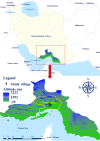Characterizing the larval habitats of the main malaria vector, Anopheles stephensi, in southern Iran
- PMID: 40598505
- PMCID: PMC12211813
- DOI: 10.1186/s12936-025-05465-9
Characterizing the larval habitats of the main malaria vector, Anopheles stephensi, in southern Iran
Abstract
Background: Vector-borne parasitic infectious diseases, particularly malaria, pose significant challenges to global public health. Understanding the environmental factors influencing the growth and reproduction of malaria vector is crucial for developing effective control strategies. This research aims to determine the abundance of larvae and the physicochemical parameters of breeding sites associated with Anopheles stephensi in southern.
Methods: A field study was conducted using standardized sampling techniques. Water samples were collected from various habitats, and physicochemical factors such as pH, temperature, turbidity, and concentrations of dissolved organic matter were measured. The population density of An. stephensi larvae was recorded and analysed in relation to these environmental parameters.
Results: A total of 1943 An. stephensi larvae were collected, with the highest abundance found in Hormoodar village. Monthly data indicated that November was the peak for larval abundance, accounting for 463 larvae, while July recorded the lowest counts. Larval abundance per 10 dipper samples was 18, with Hormoodar consistently supporting a higher density of larvae, likely due to favourable environmental conditions. Environmental analysis revealed average monthly temperatures ranging from 9 °C in February to 35 °C in August, with higher temperatures correlating with increased larval abundance. Water temperature ranging from 12 °C in February to 35 °C in August, with significant correlations observed between warmer water temperatures and larval counts (p-value < 0.05). Most larval habitats were classified as temporary stagnant water bodies, with varying degrees of vegetation cover and substrate types. Chemical analyses showed neutral pH levels across habitats, but higher turbidity and electrical conductivity in Geno village compared to the other regions, indicating distinct environmental characteristics that may influence larval survival and development.
Conclusion and discussion: This study highlights the critical role of physicochemical parameters in shaping the larval habitats of An. stephensi, a significant malaria vector in southern Iran. Understanding these environmental factors is vital for developing effective malaria control strategies, particularly in regions facing increasing insecticide resistance. The findings underscore the importance of managing artificial breeding sites to mitigate malaria transmission effectively.
Keywords: Anopheles stephensi; Iran; Larval habitat; Malaria.
© 2025. The Author(s).
Conflict of interest statement
Declarations. Ethics approval and consent to participate: This project is supported by Ethic code. IR.TUMS.SPH.REC.1396.3287 from Tehran University of Medical Sciences. Consent for publication: Not applicable. Competing interests: The authors declare that they have no competing interests.
Figures




Similar articles
-
Bionomics of Anopheles stephensi across the urban-rural landscapes of Eastern Ethiopia.Malar J. 2025 Aug 23;24(1):274. doi: 10.1186/s12936-025-05527-y. Malar J. 2025. PMID: 40849467 Free PMC article.
-
Larvivorous fish for preventing malaria transmission.Cochrane Database Syst Rev. 2017 Dec 11;12(12):CD008090. doi: 10.1002/14651858.CD008090.pub3. Cochrane Database Syst Rev. 2017. PMID: 29226959 Free PMC article.
-
Characterization of Anopheles mosquito breeding habitats for malaria vector control in Mazowe and Shamva districts, Zimbabwe.J Vector Borne Dis. 2025 Apr 1;62(2):154-164. doi: 10.4103/JVBD.JVBD_85_24. Epub 2024 Oct 5. J Vector Borne Dis. 2025. PMID: 39373225
-
Evaluation of the effectiveness of Aquatain, Bacillus thuringiensis var. israelensis, and Temephos on Anopheles arabiensis and Anopheles stephensi larvae in the laboratory and field settings.Parasit Vectors. 2025 Jun 17;18(1):223. doi: 10.1186/s13071-025-06765-4. Parasit Vectors. 2025. PMID: 40528257 Free PMC article.
-
A quantitative and systematic analysis of Anopheles stephensi bionomics and control approaches.Acta Trop. 2024 Dec;260:107431. doi: 10.1016/j.actatropica.2024.107431. Epub 2024 Oct 19. Acta Trop. 2024. PMID: 39427695 Free PMC article.
References
-
- WHO. World malaria report 2024: addressing inequity in the global malaria response. Geneva: World Health Organization; 2024. Available at: https://www.who.int/teams/global-malaria-programme/reports/world-malaria...
-
- Abbasi M, Foroushani AR, Jafari-Koshki T, Pakdad K, Vatandoost H, Hanafi-Bojd AA. The impact of climatic variables on the population dynamics of the main malaria vector, Anopheles stephensi Liston (Diptera: Culicidae), in southern Iran. Asian Pacific J Trop Med. 2020;13:448–55.
-
- Abbasi M, Oshaghi M, Sedaghat MM, Hazratian T, Foroushani A, Jafari-Koshki T, et al. Development of a degree-day model to predict the growth of Anopheles stephensi (Diptera: Culicidae): implication for vector control management. Environ Entomol. 2023;52:1126–38. - PubMed
MeSH terms
LinkOut - more resources
Full Text Sources

